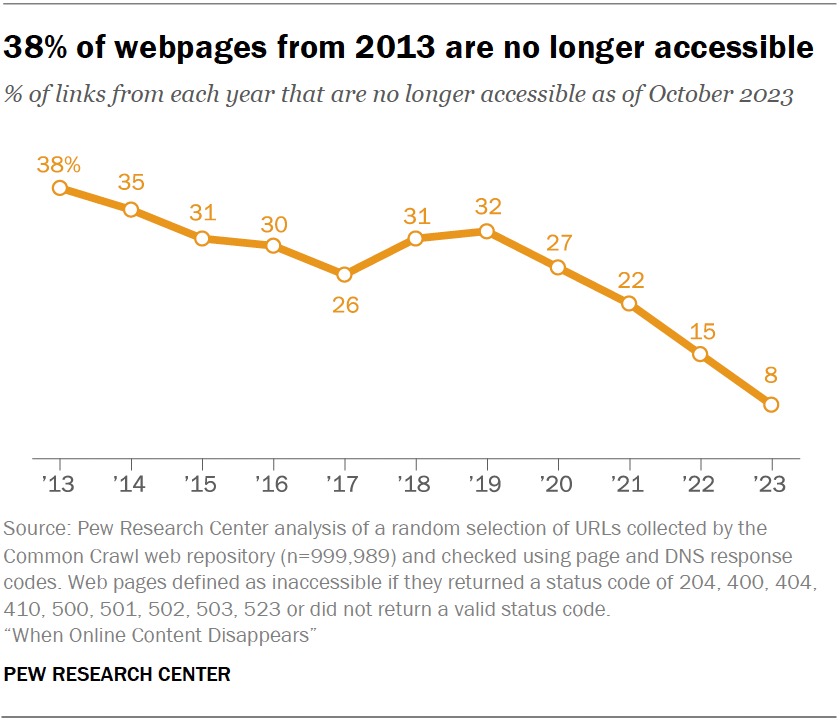It’s easy to imagine that when something’s out there on the internet it’s there forever (this feeling is doubled when it’s an embarrassing photo or a poem you wrote as a teenager). However, new research shows that this isn’t necessarily true: 38% of web pages that existed in 2013 are no longer available due to digital decay.
The research, conducted by the Pew Research Centre, found that digital decay happens on a sliding scale over time. Taken in aggregate, a quarter of all web pages that existed at any time between 2013 and 2023 are no longer accessible.
To further contextualize this, the decay rate is greater the further back in time you look. While only 8% of pages from 2023 are no longer accessible, about 38% of pages from 2013 can no longer be accessed.

The Pew Research Center dove deeper and looked in detail at what kind of pages now have ‘broken links’ (links that no longer go to a valid webpage) and at what rate. They found that 23% of news web pages contain at least one broken link and that how high-traffic the page was did not affect its chances of having a broken link.
They also found that 21% of web pages on government websites had at least one broken link, as anyone who has tried to find out when their local DMV offices open can surely attest. Local and city-level governments were even more likely to have broken links.
One fascinating statistic found was that over half (54%) of Wikipedia pages have broken links in their ‘References’ list. Wikipedia is often the starting point for anyone looking to learn something, with the references a natural springboard to deeper research, so this is undoubtedly a frustration for many.
What causes digital decay?
For the purposes of this study, the Pew Research Center looked specifically at pages that no longer exist. Perhaps the website has been taken down or the page itself deleted. Most people who were blogging in the 2000s and 2010s will have lost track of at least one website that they were definitely going to keep updated this time. If you fail to renew a domain name or your hosting fees, that website is gone.
However, beyond the study, there are other forms of digital decay. A key example is when a web page has been changed or altered significantly enough that it, for all intents and purposes, is a new page just on the same URL. Hacked pages are a key example of this.
There are also those web pages that are simply inaccessible to some users, for example, blind or visually impaired people. If a screen reader can’t interpret a page, it’s essentially decayed for some users.
Digital decay on social media
Pew’s research also looked into how digital decay affects social media websites, specifically X. They collected a sample of posts in spring 2023 and followed them, evaluating the state of the links contained within.
They found that nearly 20% of posts are no longer publically visible just months after being posted. In 60% of cases, this is because the account that made the post has been deleted, suspended, or made private, and in the other 40% it was because the individual post had been deleted or otherwise removed.
Some factors indicated a post on X would be more likely to decay – over 40% of posts in Arabic or Turkish are removed within months. In addition, posts from users with default profile settings are more likely to be removed.
It would be fascinating if future studies could look into the digital decay rates of artificial intelligence (AI) generated content on X, as AI is a key focus for Musk and X at the moment and doubtlessly into the future also.


















